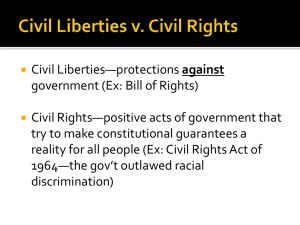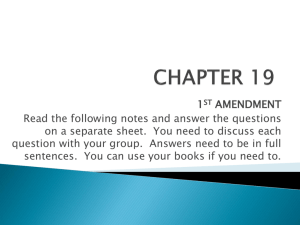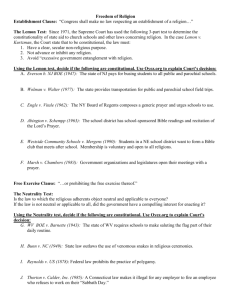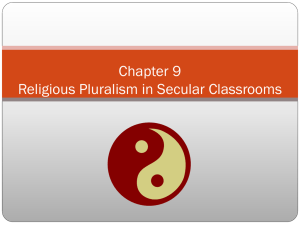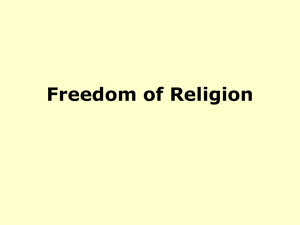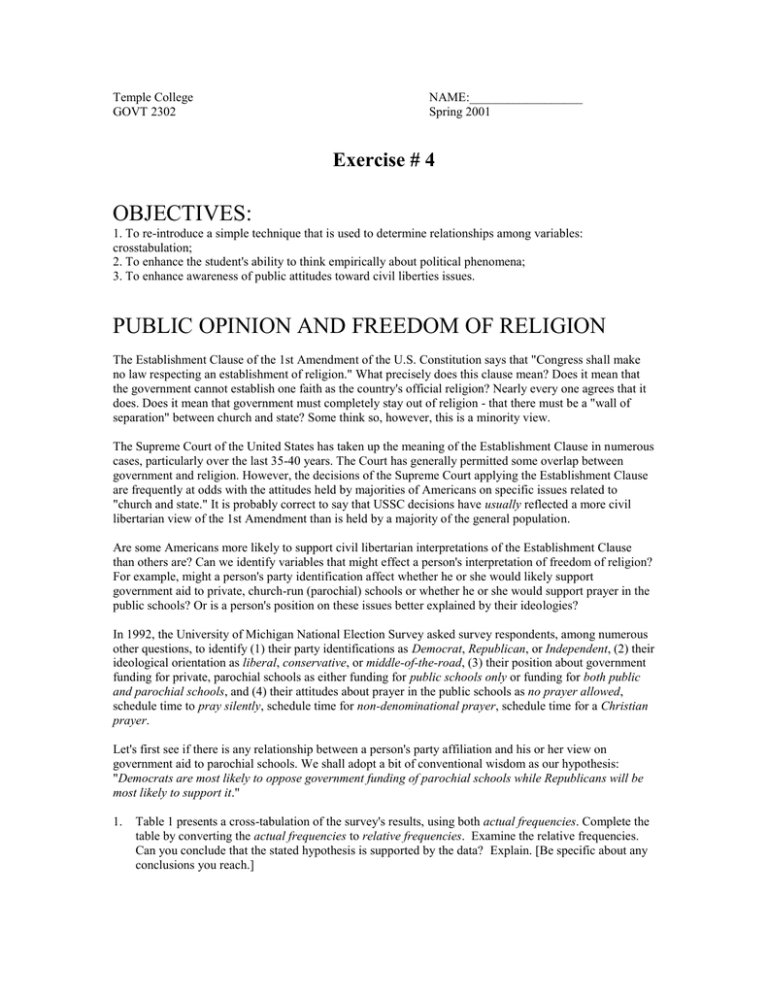
Temple College
GOVT 2302
NAME:__________________
Spring 2001
Exercise # 4
OBJECTIVES:
1. To re-introduce a simple technique that is used to determine relationships among variables:
crosstabulation;
2. To enhance the student's ability to think empirically about political phenomena;
3. To enhance awareness of public attitudes toward civil liberties issues.
PUBLIC OPINION AND FREEDOM OF RELIGION
The Establishment Clause of the 1st Amendment of the U.S. Constitution says that "Congress shall make
no law respecting an establishment of religion." What precisely does this clause mean? Does it mean that
the government cannot establish one faith as the country's official religion? Nearly every one agrees that it
does. Does it mean that government must completely stay out of religion - that there must be a "wall of
separation" between church and state? Some think so, however, this is a minority view.
The Supreme Court of the United States has taken up the meaning of the Establishment Clause in numerous
cases, particularly over the last 35-40 years. The Court has generally permitted some overlap between
government and religion. However, the decisions of the Supreme Court applying the Establishment Clause
are frequently at odds with the attitudes held by majorities of Americans on specific issues related to
"church and state." It is probably correct to say that USSC decisions have usually reflected a more civil
libertarian view of the 1st Amendment than is held by a majority of the general population.
Are some Americans more likely to support civil libertarian interpretations of the Establishment Clause
than others are? Can we identify variables that might effect a person's interpretation of freedom of religion?
For example, might a person's party identification affect whether he or she would likely support
government aid to private, church-run (parochial) schools or whether he or she would support prayer in the
public schools? Or is a person's position on these issues better explained by their ideologies?
In 1992, the University of Michigan National Election Survey asked survey respondents, among numerous
other questions, to identify (1) their party identifications as Democrat, Republican, or Independent, (2) their
ideological orientation as liberal, conservative, or middle-of-the-road, (3) their position about government
funding for private, parochial schools as either funding for public schools only or funding for both public
and parochial schools, and (4) their attitudes about prayer in the public schools as no prayer allowed,
schedule time to pray silently, schedule time for non-denominational prayer, schedule time for a Christian
prayer.
Let's first see if there is any relationship between a person's party affiliation and his or her view on
government aid to parochial schools. We shall adopt a bit of conventional wisdom as our hypothesis:
"Democrats are most likely to oppose government funding of parochial schools while Republicans will be
most likely to support it."
1.
Table 1 presents a cross-tabulation of the survey's results, using both actual frequencies. Complete the
table by converting the actual frequencies to relative frequencies. Examine the relative frequencies.
Can you conclude that the stated hypothesis is supported by the data? Explain. [Be specific about any
conclusions you reach.]
Table 1. Party Identification and Support for Government Aid to Parochial Schools
PAROCHIAL AID
Party
Identification
Republican
Independent
Democrat TOTAL
Public schools only
a 105
%
b 118
%
c 183
%
406
%
Both public and parochial schools
d 87
%
e 105
%
f 105
%
297
%
TOTAL
192
100%
223
100%
288
100%
703
100%
SOURCE: "The National Election Study, 1992," the University of Michigan, Center for Political Studies,
as reported by Eric Plutzer, Your Research: Data Analysis for American Government and Politics, West
Publishing Co., Inc. 1994.
2. Complete Tables 2, 3, and 4 by converting the actual frequencies into relative frequencies.
Table 2. Ideology and Support for Government Aid to Parochial Schools
Ideology
PAROCHIAL AID
Public schools only
Both public and parochial schools
TOTAL
Liberal
a 172
Moderate
b 26
%
d 86
C 204
%
e 26
%
258
100%
Conservative
402
%
f 174
%
52
100%
TOTAL
%
286
%
378
100%
%
688
100%
SOURCE: "The National Election Study, 1992," the University of Michigan, Center for Political Studies,
as reported by Eric Plutzer, Your Research: Data Analysis for American Government and Politics, West
Publishing Co., Inc. 1994.
Table 3. Party Identification and Support for Prayer in Public Schools
Position on Prayer in
Public Schools
Total Ban
Moment of Silence
Non-Denominational Classroom (Oral)
Christian (Oral)
TOTAL
Party
Identification
Republican
Independent
a 16
b 30
c 39
%
d 114
%
%
i 88
%
l 50
%
%
88
%
261
100%
%
223
%
k 20
%
423
%
%
218
100%
%
f 163
h 65
j 18
85
%
e 146
g 70
Democrat TOTAL
%
340
100%
%
819
100%
SOURCE: "The National Election Study, 1992," the University of Michigan, Center for Political Studies,
as reported by Eric Plutzer, Your Research: Data Analysis for American Government and Politics, West
Publishing Co., Inc. 1994.
Table 4. Ideology and Support for Prayer in Public Schools
Ideology
Position on Prayer in
Public Schools
Total Ban
Moment of Silence
Non-Denominational Classroom (Oral)
Christian (Oral)
TOTAL
Liberal
a 44
Moderate Conservative
b6
%
d 132
%
e 33
%
g 70
f 242
h 19
j 29
%
226
%
l 48
%
62
100%
407
i 137
k4
%
%
%
%
86
%
%
%
275
100%
c 36
TOTAL
%
81
%
463
100%
%
800
100%
SOURCE: "The National Election Study, 1992," the University of Michigan, Center for Political Studies,
as reported by Eric Plutzer, Your Research: Data Analysis for American Government and Politics, West
Publishing Co., Inc. 1994.
2.
State a testable hypothesis for each of the three relationships indicated by Tables 2, 3, and 4. [You
need to state three separate hypotheses: one for Ideology and Government Aid for Parochial Schools,
one for Party ID and Prayer in Public Schools, and one for Ideology and Prayer in Public Schools.]
Please write NEATLY!
3.
Do the cross-tabulations in each table indicate support for your hypotheses? Explain why or why not
for each relationship.
4. Are you surprised by the results of the cross-tabulations? Explain why or why not for each relationship.
Copyright by Wm. Feagin, Jr. 2001. All rights reserved.

